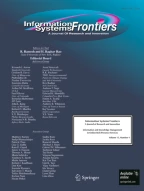Abstract
Preferences play a crucial role in the theory of rationality, and therefore also to computational social choice and artificial intelligence. In formal models it is usually assumed that preferences are primitive objects, and little concern is devoted to the question of how they are formed or where they come from. Recent work in rational choice theory challenges this assumption, however, and aims to give more internal structure to the notion of a preference. The focus so far has been on modeling faculties of individual agents, such as their mood, mindset, and motivating reasons. In this paper we contribute to this development by developing a modal logic for reasoning about preferences that depend on a set of motivationally salient properties. The main result is a translation showing how reasoning in this logic can be captured by reasoning in a standard modal logic (KT with universal modality). It follows that reasoning systems and algorithms developed for modal logic (with universal modality) can be employed for reasoning about reason-based preferences. We then discuss how the approach can be generalised to the multi-agent case, and allows us to reason about agents who disagree because they are motivated by different factors, and who might be able to reach consensus simply by changing their perspective.
Similar content being viewed by others
Notes
The finiteness assumption is not made in Dietrich and List (2011b).
This definition amounts to an extensional definition of alternatives, identifying alternatives with the properties they have, and relies on the assumption that alternatives can be completely characterised by using only such properties that could potentially be considered relevant. In Dietrich and List (2011b), an intentional approach is used instead. The intentional approach is more general, but for our purposes the two approaches are equivalent, and we have chosen the extensional approach for ease of presentation.
In fact, since we will encode the structure using a weighing relation, it must be property-based, from which indifference follows automatically for this case.
A single view might correspond to various combinations of alternatives and sets of motivating reasons, but at least one. In the example the view ∅ represents the apple under M = ∅ and the orange under any M.
Let us also remark that the universal modality can be defined by A ϕ=[∅]ϕ.
Note that M is a part of the name and not a parameter.
This does not mean that the frame itself is required to be a collection of total orders, a phenomenon that is discussed further in Dietrich and List (Dietrich and List 2011a), where conditions are also stipulated ensuring that encodings of motivational systems must themselves be total orders on views. It is shown, in particular, that this happens just in case the views are completely instantiated, i.e., for every view there is an alternative that is identical to it. Further exploration of this notion in logical terms is a topic we intend to investigate in future work.
To further clarify the meaning of A 5, it might help to notice that the boxed sub-formulae \(\square \left ((x \cap M)^{\phi } \to \bigvee _{z \in X}(z \cap M6{\prime })^{\phi }\right )\) can be everywhere replaced by formulae of the form \(\lozenge \left ((x \cap M)^{\phi } \land \bigvee _{z \in X}(z \cap M^{\prime })^{\phi }\right )\). The effect would be the same; we would still require (x∩M)=(z∩M ′) for some \(z \in X, M^{\prime } \in \mathcal M\), which is exactly what we need.
It is just a slight variation of the standard truth-preservation result for bisimulations, adapted to account for the fact that preservation is only required to hold for symbols in M ⊤. Formally, a simple induction on the complexity of formulae will do, taking note also of the fact that formulae from \(\mathcal L\) only involve variables from M ⊤.
One might interpret this in other ways as well; the agents might contribute only one preference-relation each, with a corresponding motivational set which details their perception of what matters, or, even, their different beliefs about what properties the alternatives really have. From this collection, provided it is property-based, we can aggregate the weighing relation and reason about relationships between the views of different agents.
References
Barone, J.E. (2000). Comparing apples and oranges: a randomised prospective study. BMJ, 321 (7276), 1569–1570.
Blackburn, P., de Rijke, M., Venema, Y. (2001). Modal Logic Vol. 53: Cambridge University Press.
Bonzon, E., & Lagasquie-Schiex, M.C. (2006). In Jerôme Lang̀: compact preference representation for boolean games. Proceedings of the 9th Pacific Rim International Conference on Artificial Intelligence (PRICAI), (pp. 41–50): Springer-Verlag.
Dietrich, F., & List, C. (2011a). A reason-based theory of rational choice. Mpra paper, University Library of Munich, Germany. http://EconPapers.repec.org/RePEc:pra:mprapa:36112.
Dietrich, F., & List, C. (2011b). Where do preferences come from? Mpra paper,University Library of Munich, Germany. http://EconPapers.repec.org/RePEc:pra:mprapa:36115.
Dietrich, F., & List, C. (2012). Mentalism versus behaviourism in economics: a philosophy-of-science perspective. Mpra paper, University Library of Munich, Germany. http://EconPapers.repec.org/RePEc:pra:mprapa:37813.
Jongh, D.d., Liu, F., Hansson, S.O. (2009). Preference, priorities and belief In Grne-Yanoff, T. (Ed.), Preference Change, Theory and Decision Library (Vol. 42, pp. 85–107). Netherlands: Springer.
Lang, J. (2002). Logical preference representation and combinatorial vote. Annals of Mathematics and Artificial Intelligence, 42, 2004.
Liu, F. (2011). In Reasoning about Preference Dynamics. Synthese Library, Studies in Epistemology, Logic, Methodology, and Philosophy of Science. Springer London, Limited.
Osherson, D., & Weinstein, S. (2012). Preference based on reasons. The Review of Symbolic Logic, 5(01), 122–147.
Author information
Authors and Affiliations
Corresponding author
Rights and permissions
About this article
Cite this article
Pedersen, T., Dyrkolbotn, S. & Ågotnes, T. Reasoning about reasons behind preferences using modal logic. Inf Syst Front 17, 713–724 (2015). https://doi.org/10.1007/s10796-014-9520-7
Published:
Issue Date:
DOI: https://doi.org/10.1007/s10796-014-9520-7
